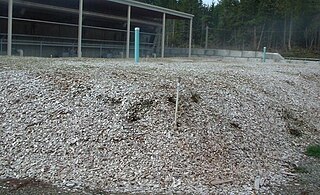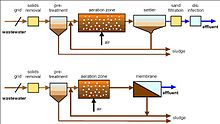Ultrafiltration (UF) is a variety of membrane filtration in which forces such as pressure or concentration gradients lead to a separation through a semipermeable membrane. Suspended solids and solutes of high molecular weight are retained in the so-called retentate, while water and low molecular weight solutes pass through the membrane in the permeate (filtrate). This separation process is used in industry and research for purifying and concentrating macromolecular (103–106 Da) solutions, especially protein solutions.
Microfiltration is a type of physical filtration process where a contaminated fluid is passed through a special pore-sized membrane filter to separate microorganisms and suspended particles from process liquid. It is commonly used in conjunction with various other separation processes such as ultrafiltration and reverse osmosis to provide a product stream which is free of undesired contaminants.

Biofiltration is a pollution control technique using a bioreactor containing living material to capture and biologically degrade pollutants. Common uses include processing waste water, capturing harmful chemicals or silt from surface runoff, and microbiotic oxidation of contaminants in air. Industrial biofiltration can be classified as the process of utilizing biological oxidation to remove volatile organic compounds, odors, and hydrocarbons.

Waste stabilization ponds are ponds designed and built for wastewater treatment to reduce the organic content and remove pathogens from wastewater. They are man-made depressions confined by earthen structures. Wastewater or "influent" enters on one side of the waste stabilization pond and exits on the other side as "effluent", after spending several days in the pond, during which treatment processes take place.

The activated sludgeprocess is a type of biological wastewater treatment process for treating sewage or industrial wastewaters using aeration and a biological floc composed of bacteria and protozoa. It uses air and microorganisms to biologically oxidize organic pollutants, producing a waste sludge containing the oxidized material.

Industrial wastewater treatment describes the processes used for treating wastewater that is produced by industries as an undesirable by-product. After treatment, the treated industrial wastewater may be reused or released to a sanitary sewer or to a surface water in the environment. Some industrial facilities generate wastewater that can be treated in sewage treatment plants. Most industrial processes, such as petroleum refineries, chemical and petrochemical plants have their own specialized facilities to treat their wastewaters so that the pollutant concentrations in the treated wastewater comply with the regulations regarding disposal of wastewaters into sewers or into rivers, lakes or oceans. This applies to industries that generate wastewater with high concentrations of organic matter, toxic pollutants or nutrients such as ammonia. Some industries install a pre-treatment system to remove some pollutants, and then discharge the partially treated wastewater to the municipal sewer system.
An aerated lagoon is a simple wastewater treatment system consisting of a pond with artificial aeration to promote the biological oxidation of wastewaters.
Enhanced biological phosphorus removal (EBPR) is a sewage treatment configuration applied to activated sludge systems for the removal of phosphate.

Secondary treatment is the removal of biodegradable organic matter from sewage or similar kinds of wastewater. The aim is to achieve a certain degree of effluent quality in a sewage treatment plant suitable for the intended disposal or reuse option. A "primary treatment" step often precedes secondary treatment, whereby physical phase separation is used to remove settleable solids. During secondary treatment, biological processes are used to remove dissolved and suspended organic matter measured as biochemical oxygen demand (BOD). These processes are performed by microorganisms in a managed aerobic or anaerobic process depending on the treatment technology. Bacteria and protozoa consume biodegradable soluble organic contaminants while reproducing to form cells of biological solids. Secondary treatment is widely used in sewage treatment and is also applicable to many agricultural and industrial wastewaters.

Aerobic granular reactors (AGR) or Aerobic granular sludge (AGS) are a community of microbial organisms, typically around 0.5-3mm in diameter, that remove carbon, nitrogen, phosphorus and other pollutants in a single sludge system. It can also be used for wastewater treatments. Aerobic granular sludge is composed of bacteria, protozoa and fungi,which allows oxygen to follow in and biologically oxidize organic pollutants. AGS is a type of wastewater treatment process for sewages and/or industrial waste treatment. AGR was first discovered by UK engineers, Edward Ardern and W.T. Lockett who were researching better ways for sewage disposal. Another scientist by the name of Dr. Gilbert Fowler, who was at the University of Manchester working on an experiment based on aeration of sewage in a bottle coated with algae. Eventually, all three scientists were able to collaborate with one another to discover AGR/AGS.

Sewage treatment is a type of wastewater treatment which aims to remove contaminants from sewage to produce an effluent that is suitable to discharge to the surrounding environment or an intended reuse application, thereby preventing water pollution from raw sewage discharges. Sewage contains wastewater from households and businesses and possibly pre-treated industrial wastewater. There are a high number of sewage treatment processes to choose from. These can range from decentralized systems to large centralized systems involving a network of pipes and pump stations which convey the sewage to a treatment plant. For cities that have a combined sewer, the sewers will also carry urban runoff (stormwater) to the sewage treatment plant. Sewage treatment often involves two main stages, called primary and secondary treatment, while advanced treatment also incorporates a tertiary treatment stage with polishing processes and nutrient removal. Secondary treatment can reduce organic matter from sewage, using aerobic or anaerobic biological processes. A so-called quarternary treatment step can also be added for the removal of organic micropollutants, such as pharmaceuticals. This has been implemented in full-scale for example in Sweden.

Membrane fouling is a process whereby a solution or a particle is deposited on a membrane surface or in membrane pores in a processes such as in a membrane bioreactor, reverse osmosis, forward osmosis, membrane distillation, ultrafiltration, microfiltration, or nanofiltration so that the membrane's performance is degraded. It is a major obstacle to the widespread use of this technology. Membrane fouling can cause severe flux decline and affect the quality of the water produced. Severe fouling may require intense chemical cleaning or membrane replacement. This increases the operating costs of a treatment plant. There are various types of foulants: colloidal, biological, organic and scaling.

The biological treatment of wastewater in the sewage treatment plant is often accomplished using conventional activated sludge systems. These systems generally require large surface areas for treatment and biomass separation units due to the generally poor settling properties of the sludge. Aerobic granules are a type of sludge that can self-immobilize flocs and microorganisms into spherical and strong compact structures. The advantages of aerobic granular sludge are excellent settleability, high biomass retention, simultaneous nutrient removal and tolerance to toxicity. Recent studies show that aerobic granular sludge treatment could be a potentially good method to treat high strength wastewaters with nutrients, toxic substances.

A membrane is a selective barrier; it allows some things to pass through but stops others. Such things may be molecules, ions, or other small particles. Membranes can be generally classified into synthetic membranes and biological membranes. Biological membranes include cell membranes ; nuclear membranes, which cover a cell nucleus; and tissue membranes, such as mucosae and serosae. Synthetic membranes are made by humans for use in laboratories and industry.
Membrane technology encompasses the scientific processes used in the construction and application of membranes. Membranes are used to facilitate the transport or rejection of substances between mediums, and the mechanical separation of gas and liquid streams. In the simplest case, filtration is achieved when the pores of the membrane are smaller than the diameter of the undesired substance, such as a harmful microorganism. Membrane technology is commonly used in industries such as water treatment, chemical and metal processing, pharmaceuticals, biotechnology, the food industry, as well as the removal of environmental pollutants.
Mixed liquor suspended solids (MLSS) is the concentration of suspended solids, in an aeration tank during the activated sludge process, which occurs during the treatment of waste water. The units MLSS is primarily measured in milligram per litre (mg/L), but for activated sludge its mostly measured in gram per litre [g/L] which is equal to kilogram per cubic metre [kg/m3]. Mixed liquor is a combination of raw or unsettled wastewater or pre-settled wastewater and activated sludge within an aeration tank. MLSS consists mostly of microorganisms and non-biodegradable suspended matter. MLSS is an important part of the activated sludge process to ensure that there is a sufficient quantity of active biomass available to consume the applied quantity of organic pollutant at any time. This is known as the food to microorganism ratio, more commonly notated as the F/M ratio. By maintaining this ratio at the appropriate level the biomass will consume high percentages of the food. This minimizes the loss of residual food in the treated effluent. In simple terms, the more the biomass consumes the lower the biochemical oxygen demand (BOD) will be in the discharge. It is important that MLSS removes COD and BOD in order to purify water for clean surface waters, and subsequently clean drinking water and hygiene. Raw sewage enters in the water treatment process with a concentration of sometimes several hundred mg/L of BOD. Upon being treated by screening, pre-settling, activated sludge processes or other methods of treatment, the concentration of BOD in water can be lowered to less than 2 mg/L, which is considered to be clean, safe to discharge to surface waters or to reuse water.

Moving bed biofilm reactor (MBBR) is a type of wastewater treatment process that was first invented by Professor Hallvard Ødegaard at Norwegian University of Science and Technology in the late 1980s. The process takes place in an aeration tank with plastic carriers that a biofilm can grow on. The compact size and cheap wastewater treatment costs offers many advantages for the system. The main objective of using MBBR being water reuse and nutrient removal or recovery. In theory, wastewater will be no longer considered waste, it can be considered a resource.
Anaerobic membrane bioreactor or AnMBR is the name of a technology utilized in wastewater treatment. It is a technology in membrane filtration for biomass retention. AnMBR works by using a membrane bioreactor (MBR) in a anaerobic environment. Anaerobic bacteria and archaea convert organic materials into carbon dioxide (CO2) and methane (CH4). The sewage is filtered and separated by membranes leaving the effluent and sludge apart. The produced biogas can later be combusted to generate heat or electricity. It can also be upgraded (purified) into Renewable natural gas of household quality. AnMBR is considered to be a sustainable alternative for sewage treatment because the energy that can be generated by methane combustion can exceed the energy required for maintaining the process.



















